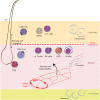A Task Force Against Local Inflammation and Cancer: Lymphocyte Trafficking to and Within the Skin
- PMID: 30405637
- PMCID: PMC6207597
- DOI: 10.3389/fimmu.2018.02454
A Task Force Against Local Inflammation and Cancer: Lymphocyte Trafficking to and Within the Skin
Abstract
The skin represents a specialized site for immune surveillance consisting of resident, inflammatory and memory populations of lymphocytes. The entry and retention of T cells, B cells, and ILCs is tightly regulated to facilitate detection of pathogens, inflammation and tumors cells. Loss of individual or multiple populations in the skin may break tolerance or increase susceptibility to tumor growth and spread. Studies have significantly advanced our understanding of the role of skin T cells and ILCs at steady state and in inflammatory settings such as viral challenge, atopy, and autoimmune inflammation. The knowledge raised by these studies can benefit to our understanding of immune cell trafficking in primary melanoma, shedding light on the mechanisms of tumor immune surveillance and to improve immunotherapy. This review will focus on the T cells, B cells, and ILCs of the skin at steady state, in inflammatory context and in melanoma. In particular, we will detail the core chemokine and adhesion molecules that regulate cell trafficking to and within the skin, which may provide therapeutic avenues to promote tumor homing for a team of lymphocytes.
Keywords: adhesion molecule; chemokine; lymphocyte trafficking; melanoma; skin.
Figures


Similar articles
-
Dendritic cell immunization route determines CD8+ T cell trafficking to inflamed skin: role for tissue microenvironment and dendritic cells in establishment of T cell-homing subsets.J Immunol. 2004 Jan 15;172(2):857-63. doi: 10.4049/jimmunol.172.2.857. J Immunol. 2004. PMID: 14707056
-
Human cerebrospinal fluid contains CD4+ memory T cells expressing gut- or skin-specific trafficking determinants: relevance for immunotherapy.BMC Immunol. 2006 Jul 7;7:14. doi: 10.1186/1471-2172-7-14. BMC Immunol. 2006. PMID: 16824229 Free PMC article.
-
Molecular mechanisms of leukocyte trafficking in T-cell-mediated skin inflammation: insights from intravital imaging.Expert Rev Mol Med. 2009 Aug 20;11:e25. doi: 10.1017/S146239940900115X. Expert Rev Mol Med. 2009. PMID: 19691914 Review.
-
Chemokine-mediated control of T cell traffic in lymphoid and peripheral tissues.Mol Immunol. 2005 May;42(7):799-809. doi: 10.1016/j.molimm.2004.06.040. Epub 2004 Nov 23. Mol Immunol. 2005. PMID: 15829268 Review.
-
Revisiting the role of B cells in skin immune surveillance.Trends Immunol. 2015 Feb;36(2):102-11. doi: 10.1016/j.it.2014.12.006. Epub 2015 Jan 21. Trends Immunol. 2015. PMID: 25616715 Review.
Cited by
-
Early melanoma invasivity correlates with gut fungal and bacterial profiles.Br J Dermatol. 2022 Jan;186(1):106-116. doi: 10.1111/bjd.20626. Epub 2021 Oct 10. Br J Dermatol. 2022. PMID: 34227096 Free PMC article.
-
Investigations on T cell transmigration in a human skin-on-chip (SoC) model.Lab Chip. 2021 Apr 20;21(8):1527-1539. doi: 10.1039/d0lc01194k. Lab Chip. 2021. PMID: 33616124 Free PMC article.
-
Emerging adjuvants for intradermal vaccination.Int J Pharm. 2023 Feb 5;632:122559. doi: 10.1016/j.ijpharm.2022.122559. Epub 2022 Dec 28. Int J Pharm. 2023. PMID: 36586639 Free PMC article. Review.
-
Investigating T Cell Immunity in Cancer: Achievements and Prospects.Int J Mol Sci. 2021 Mar 12;22(6):2907. doi: 10.3390/ijms22062907. Int J Mol Sci. 2021. PMID: 33809369 Free PMC article. Review.
-
CCR7 in Blood Cancers - Review of Its Pathophysiological Roles and the Potential as a Therapeutic Target.Front Oncol. 2021 Oct 29;11:736758. doi: 10.3389/fonc.2021.736758. eCollection 2021. Front Oncol. 2021. PMID: 34778050 Free PMC article. Review.
References
Publication types
MeSH terms
Substances
LinkOut - more resources
Full Text Sources
Medical

